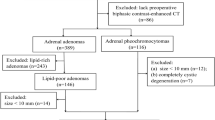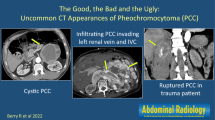Abstract
The purpose of this study was to retrospectively evaluate the enhancement washout and other imaging features of pheochromocytomas on delayed contrast-enhanced CT. Twenty-four patients with 31 pathologically confirmed pheochromocytomas were examined using unenhanced, early and delayed contrast-enhanced CT. The range of their APEW (absolute percentage of enhancement washout) or RPEW (relative PEW) values was analyzed. The other CT features including cystic or necrotic change, calcification, and hemorrhage were also determined by a pathologic correlation. Of the 31 pheochromocytomas, 10 (32%) had APEW values of 60% or less and RPEW values of 40% or less. Fourteen (45%) had APEW values >60% and RPEW values >40%. CT showed cystic or necrotic changes in 11 pheochromocytomas (35%) and calcification (10%) in 3. Nineteen pheochromocytomas showed cystic or necrotic changes on early contrast-enhanced CT, but eight of these lesions showed late enhancement on delayed contrast-enhanced CT, which pathologically corresponded to myxoid degeneration. The unenhanced CT showed hemorrhage in 23 pheochromocytomas, but the pathology examinations showed hemorrhage in 15 lesions. Many pheochromocytomas can be misdiagnosed as adenomas on CT due to the high enhancement washout values. Delayed contrast-enhanced CT can detect myxoid degeneration with late enhancement, which is seen as a cystic or necrotic change on early contrast-enhanced CT.





Similar content being viewed by others
References
Witteles RM, Kaplan EL, Roizen MF (2000) Sensitivity of diagnostic and localization tests for pheochromocytoma in clinical practice. Arch Intern Med 160:2521–2524
Lucon AM, Pereira MA, Mendonca BB, Halpern A, Wajchenbeg BL, Arap S (1997) Pheochromocytoma: study of 50 cases. J Urol 157:1208–1212
Cook DM, Loriaux DL (1996) The incidental adrenal mass. Am J Med 101:88–94
Szolar DH, Korobkin M, Reittner P, Berghold A, Bauernhofer T, Trummer H, Schoellnast H, Preidler KW, Samonigg H (2005) Adrenocortical carcinomas and adrenal pheochromocytomas: mass and enhancement loss evaluation at delayed contrast-enhanced CT. Radiology 234:479–485
Blake MA, Kalra MK, Maher MM, Sahani DV, Sweeney AT, Mueller PR, Hahn PF, Boland GW (2004) Pheochromocytoma: an imaging chameleon. Radiographics 24 Suppl 1:S87–S99
Blake MA, Krishnamoorthy SK, Boland GW, Sweeney AT, Pitman MB, Harisinghani M, Mueller PR, Hahn PF (2003) Low-density pheochromocytoma on CT: a mimicker of adrenal adenoma. AJR Am J Roentgenol 181:1663–1668
Caoili EM, Korobkin M, Francis IR, Cohan RH, Platt JF, Dunnick NR, Raghupathi KI (2002) Adrenal masses: characterization with combined unenhanced and delayed enhanced CT. Radiology 222:629–633
Kalra MK, Blake MA, Boland GW, Hahn PF (2005) CT features of adrenal pheochromocytomas: attenuation value and loss of contrast enhancement. Radiology 236:1112–1113
Park BK, Kim B, Ko K, Jeong SY, Kwon GY (2006) Adrenal masses falsely diagnosed as adenomas on unenhanced and delayed contrast-enhanced computed tomography: pathological correlation. Eur Radiol 16:642–647
Motta-Ramirez GA, Remer EM, Herts BR, Gill IS, Hamrahian AH (2005) Comparison of CT findings in symptomatic and incidentally discovered pheochromocytomas. AJR Am J Roentgenol 185:684–688
Young WF Jr (2007) Clinical practice. The incidentally discovered adrenal mass. N Engl J Med 356:601–610
Bravo EL, Gifford RW Jr (1984) Current concepts. Pheochromocytoma: diagnosis, localization and management. N Engl J Med 311:1298–1303
Szolar DH, Kammerhuber FH (1998) Adrenal adenomas and nonadenomas: assessment of washout at delayed contrast-enhanced CT. Radiology 207:369–375
Pena CS, Boland GW, Hahn PF, Lee MJ, Mueller PR (2000) Characterization of indeterminate (lipid-poor) adrenal masses: use of washout characteristics at contrast-enhanced CT. Radiology 217:798–802
Korobkin M, Brodeur FJ, Francis IR, Quint LE, Dunnick NR, Londy F (1998) CT time-attenuation washout curves of adrenal adenomas and nonadenomas. AJR Am J Roentgenol 170:747–752
Author information
Authors and Affiliations
Corresponding author
Rights and permissions
About this article
Cite this article
Park, B.K., Kim, C.K., Kwon, G.Y. et al. Re-evaluation of pheochromocytomas on delayed contrast-enhanced CT: washout enhancement and other imaging features. Eur Radiol 17, 2804–2809 (2007). https://doi.org/10.1007/s00330-007-0695-x
Received:
Revised:
Accepted:
Published:
Issue Date:
DOI: https://doi.org/10.1007/s00330-007-0695-x




